In an intriguing interview last month, architect Richard Rogers claimed he would “absolutely” live on Robin Hood Gardens, E14, the decaying, brutalist, Smithson-designed 1970s estate earmarked for demolition – or, as Rogers described it, “the best piece of social and architectural thinking in the last 50 years”.
So Robin Hood Gardens, which forms part of the Blackwall Reach regeneration project that has begun to provide more than 1,500 new homes, joins a long list of contentious plans to redevelop the capital’s post-war estates. For leading architects, leaseholders fearing they will be ripped off, social tenants worried about “gentrification” and politicians
in lively debate about Right to Buy, estate renewal is challenging at the moment.
Yet if London is to meet its ambitious housebuilding targets within its current boundaries, existing estates will have to be redeveloped.
Developments no longer fit for purpose and beyond Decent Homes should be redeveloped, providing not just more homes of all tenures, but ones that are warmer, safer and within a setting offering higher-quality landscaping and public realm.
About 100 regeneration schemes are under way. Critically, these include almost every major post-war estate in London, through partnerships between boroughs, housing associations, developers, and often the GLA. They include some of the largest estates in Europe, such as the Aylesbury, Southwark and Thamesmead in Bexley/Greenwich.
Despite the controversies, there are still signs of an emerging political consensus in favour of more estate regeneration in London. This requires, of course, strong local borough leadership and careful and continuous dialogue with residents. It also needs a clear message that affordable homes will be reprovided.
The latest analysis of estate regeneration commitments reveals not just a much-needed doubling of the number of homes on existing sites, but overall more affordable homes, with 31,000 in the pipeline.
Estate regeneration requires huge financial capacity, and the early capital lock-up in schemes that will take many years to complete is often large.
How to reduce the cost of that capital is something the GLA has been focused on. It led to the launch of a £150m estate regeneration fund last year, in partnership with the government, offering cheaper project finance and helping to accelerate build-out rates.
These schemes are also great candidates for the emerging purpose-built rented sector and shared-ownership models.
There is much focus on the design of buildings, particularly given the higher densities of new schemes, but the public realm is equally important. This means the early adoption of exemplary designed, high-quality, mature landscaping. Examples of this include Berkeley’s scheme at Kidbrooke and Lend Lease’s regeneration plans in Elephant & Castle.
The UK is arguably a world leader in high-quality, innovative regeneration. Interest in redeveloping estates is growing, with several proposals coming forward as part of London’s Housing Zones initiative. It is essential for London, and those people who desperately need new homes, that it succeeds.
Richard Blakeway, deputy mayor for housing, land & property












